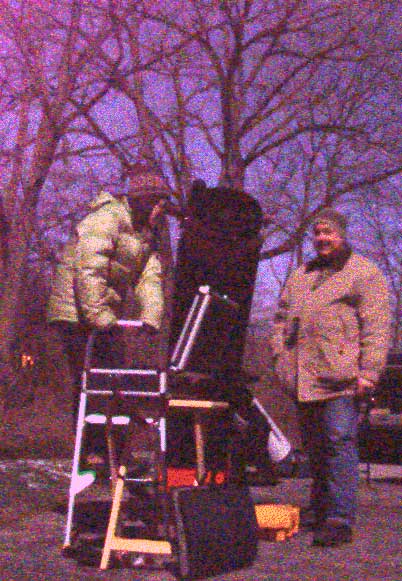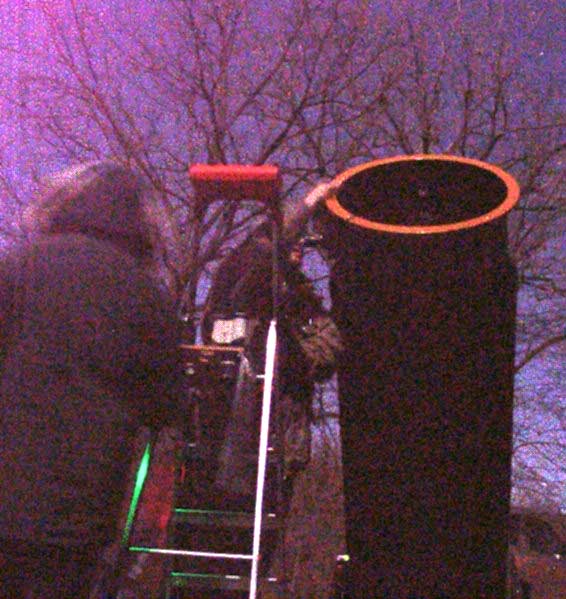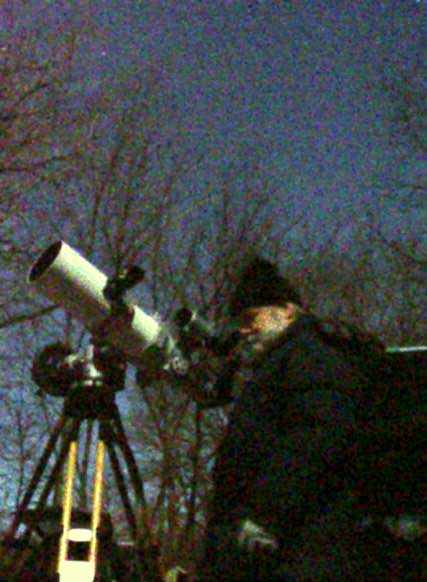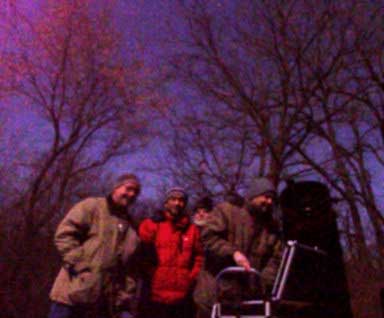

Some of you may not be aware of the ACNO group in the Lowbrows; ACNO stands for Any Clear Night Observers and consists of Lowbrow members who take it upon themselves to organize impromptu observing session on any clear night. These sessions can be held just about anywhere from Peach Mt to John Causland’s driveway to Leslie Park to Lake Hudson State Recreation Area and are not part of the Lowbrows’ normal open house schedule. These sessions are usually organized by email and at the last minute, but can sometimes prove to be quite wonderful.
Here are a few observing reports of typical ACNO sessions:
Flying in the face of conventional wisdom, Jim Forrester and Mike Radwick joined me in thumbing our noses at the pesky moon tonight, in search of extra-solar photons (important to recall that moonshine is slightly delayed and reflected sunshine....) After 2 months of extreme deprivation, the likes of which none of us can recall, any opportunity to observe was a good opportunity. The hole lasted until 10:30, so 4 hours of 40 degree observing was quite satisfactory.
We brought out our various unused Christmas presents and put them to the test tonight. However, I’m sworn to not reveal the nature of some of them for the purposes of future unveilings. See, you should have been there! Anyway, it had been so long that hitting the usual open clustered Messiers was fun, taking a side trip to some nebulosity in Orion, and triple and quadruple stars in the vicinity. Getting away from Luna, we zipped around Cassiopeia and M34, M31, M32, and even M76, (The little dumbbell) was cooperative. We got some NGC Open Clusters in for good measure too.
Though an ever present breeze blew and shook the sails of the 61’s shroud, we got some Martian detail and capped the evening off finally with Saturn breaking the tree line. The Cassini and the crepe ring obliging, but shakiness obscuring Encke’s division. It’ll be a fun season ahead with Saturn keeping us company and entertaining the “Open Housers.”
Sorry for the extended detail, but thought it would be good to remind Lowbrows what that long forgotten, out of sight out of mind, “observaytin’” experience is like. At least a few of us got the year off to an extended evening’s start and replenished photons.
Even with the Full Moon rising, those intrepid Lowbrows again found themselves back at John Causland’s house on Saturday night fighting for ever photon they could gather. This time John, Jim and Mike were joined by Yasu & Yumi Inugi, Ken Cook & son Paul, and me and no one was disappointed. The skies were crisp and clear, the wind was almost negligible, Mars gave up lots of surface detail and Saturn’s ring system wowed us.
Mike took over the 61 and hunted down a half a dozen Open Clusters, and from time to time when John could gain control of his own scope he’d slew it over to some real eye candy, like the Great Orion Nebula.
Yasu & Yumi had brought a couple of very cool “toys” including their digital camera, which they managed to document the evening with, taking moonlight photos of the group in fifteen second exposures (featured below). They also brought along a couple of the coolest “Home Planetarium” that anyone of us had ever seen. Yasu demonstrated one of them at the January meeting, if you missed it; you real missed a cool presentation.
We all took turns entertaining young Paul Cook by showing him some of the night’s best features, including an extremely filtered look at the Full Moon. Toward the end of the night I pulled out the UHC filter and attached it to my 38mm Erfle and then slid my 12.5” over to M42, for a wide field look at all the nebulosity. Sometimes you just need to absorb that nebulous light in its entirety!




We came. We observed. And we didn’t freeze any extremities either! On the evening of Saturday January 21, 2006, the clouds parted and we were treated to what one might call a special night of observing at Peach Mountain. Jim Forrester, Mark Deprest, Nate Murphy, Mike Radwick, Yasu & Yumi, Bobby & Joni G, David Tucker, Jim & Kelly & family (sorry, I don’t know your last name), and yours truly gathered at Peach Mountain on the evening of January 21, 2006, for some long-awaited photon gathering. It was a particularly mild evening, for January at least, with temperatures falling from the mid-30s “only” down to the mid-twenties by midnight. Almost balmy!
I brought a borrowed Vixen Great Polaris mount for a shake down cruise. I was considering buying it from Nathan Murphy, who had loaned it to me for evaluation. I planned to snap a few wide field images by piggy-backing my old OM-1 film camera on it, and also try his 80 mm TMB refractor on it, to see how well the RA drive tracks. Knowing that Saturn was nearing opposition, I also brought my eight-inch f/8 “Mars Scope” for some high-power viewing between exposures.
The “stars” of the evening weren’t stars at all - but planets. As the sky darkened, Mars was an obvious target nearly straight overhead. The Red Planet, well past opposition, is fast receding from Earth, but it still shone at a decidedly orange magnitude zero. Its obviously gibbous disk (only 90% illuminated) had shrunk to just under ten arc seconds top to bottom, but it still gave up some detail in the eyepiece. Mares Sirenum and Cimmerium could still be seen running diagonally across the southern hemisphere. Boy, the air sure is steady tonight we all agreed.
Later in the evening, as it gained some altitude, most of us turned our scopes towards the spectacular ringed world Saturn. And it did not disappoint. Less than a week before opposition, it appeared about as large as it ever does. And the ring plane, while slowly closing, is still open quite wide, allowing for some good detail in the rings to be seen. Cassini (the division in the rings, not the orbiting spacecraft!) was obvious, but we could also see some graduated shading in the rings. The inside of the B ring was clearly a darker gray than the outer portions, and the C ring, also known as the crepe ring, also made an appearance. During particularly steady moments, which were frequent in the earlier part of the evening, we thought we could see some darkening in the middle of the A ring, which is sometimes called the Encke Minima (not to be confused with the Encke division, which requires near perfect seeing and optics to observe). Even though Saturn was less than a week from opposition, one could see just the thinnest hairline of a shadow from the ball of the planet falling on the far side of the rings on one side. Several faint yet obvious cloud bands were visible across the globe, and when the air settled I saw an irregular outline on the most prominent one near the equator. And of course there were several moons scattered around the planet. It was an unforgettable sight - the steadiness really was exceptional. I’m glad the Mars Scope works on other planets too!
We took advantage of the good seeing and also partook of some close doubles. Like a 1.5 arc second beauty in Orion, which we were all pretty much able to split. And another one nearby which was not real close but had a beautiful contrast. The primary was a brilliant orange with the faint companion being a rich blue. Of course we had to spend some time on the Trapezium, in the heart of the Orion nebula. The four main stars were very cleanly split, and were joined by the 11th magnitude E and F stars in most scopes. We even thought we glimpsed one of them momentarily in Nate’s 80mm TMB. Or maybe we were using averted imagination?
The Great Polaris mount proved itself to work superbly. With Nate’s refractor on it, even at magnifications over 100 per inch of aperture, centered objects stayed centered. I even set a bright star right at the edge of the field of view but I was unable to detect any movement over a few minutes. I had a little bit of trouble with the camera, the shutter was a little slow to close after being open for several minutes, but I still got some good wide field shots of the constellation Orion. Even with the 200mm lens, and an exposure time of five minutes, without guiding, stars are pinpoints right to the corners. Yes, this mount is a keeper, and I’ve since happily handed my payment over to Nate.
I would like to take this opportunity to mention something about headlight etiquette at Peach Mountain, particularly when we are set up near the radio dish as we were that night. Several times folks drove up to that area with their headlights on, which was most disturbing to those of us who were dark adapted, or who were trying to take astrophotos (as I was). Please, if you must arrive after dark, then drive up with your parking lights only. If your vehicle won’t let you turn off the headlights, then please stop further down the road before you flood the observing area with unwanted photons. And please be sensitive of your backup lights, too, which are also white. Don’t put your car into reverse until you are ready to go, so that they are on for as short a time period as possible. And please, make an announcement beforehand so that everyone has time to turn away and cover lenses.
Thanks, I feel better now.
I’m not sure what all everyone else was observing. I know Mark was trying a galaxy trio or two. The Eskimo nebula in Gemini made an appearance, and I’m sure the bright open clusters in Auriga and Gemini, as well as the Double Cluster, did as well. It was after midnight before many of us left, when toes were finally complaining about the lack of heat. But being able to observe several hours in Michigan in January? - Priceless!
Stargazing in Michigan in the winter can be daunting, from week after week or even month after month with nothing but clouds, to the risk of frostbite when it finally does clear. Which is why I like to say that, “observing in these parts ain’t for sissies.” So when we are finally blessed with clear skies, relatively mild temperatures, with no moon, superb atmospheric seeing, and on a Saturday night no less, then that’s pretty special.
Pretty special indeed!